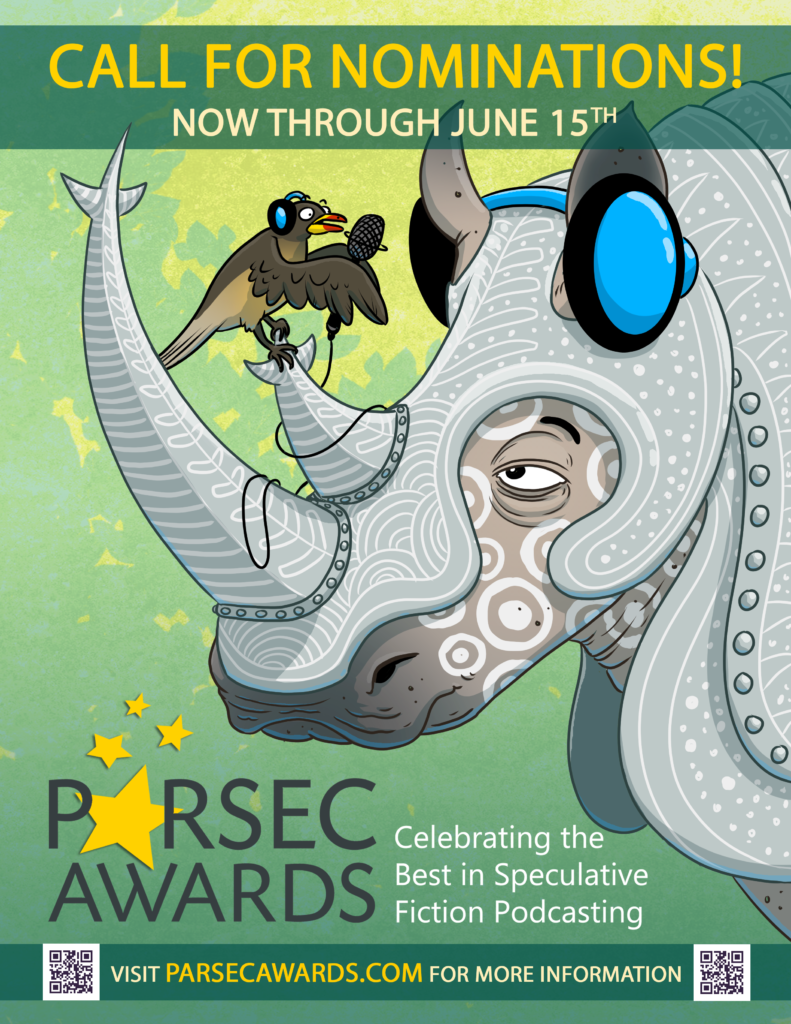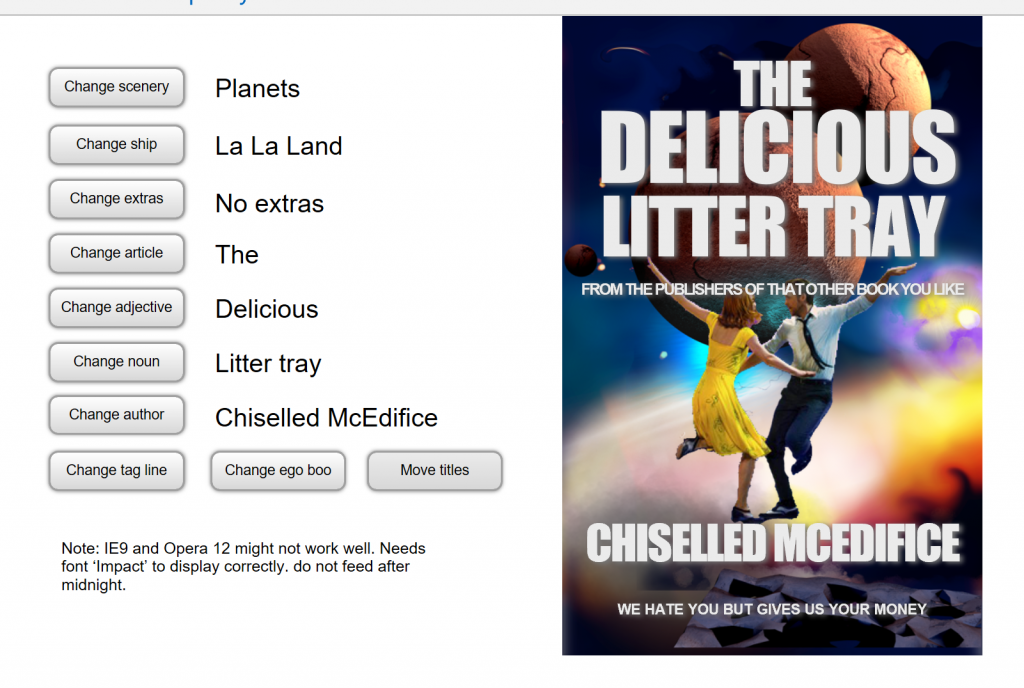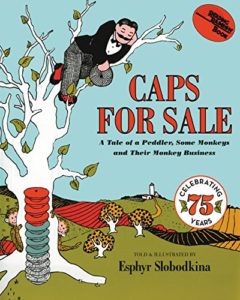(1) #2018NEBULAS. More from Grandmaster Peter S. Beagle’s reception.
https://twitter.com/jasonsanford/status/997278820364365824
There’s an amazing galactic unicorn cake at the #Nebulas2018. (Because Peter Beagle, probably.) pic.twitter.com/WkRxy3y0tQ
— Sarah Guan (@Sarah_Guan) May 18, 2018
(2) #2018NEBULAS PANEL LIVETWEET. All summed up here: “Thread by @sfwa: ‘Hello ! Panel live tweet starts NOW, with “How to fail gracefully,” with Michael Underwood, Carrie DiRisio, Vanessa Rose Phin, […]’”
(3) #2018NEBULAS LIVESTREAM. Really?
Thanks for watching @sfwa's #Nebulas2018 livestream! Programming resumes tomorrow EDT:
1pm How to Teach Classes in Storytelling
2:30pm Social Media Theory and Practice
4pm What Science Fiction Can Learn from Archaeology
7:15pm Market Presentation by Data Guy
8:30pm Nebula Awards! pic.twitter.com/VCbz8D7wPQ— Diane Morrison (Sable Aradia)|????Creatrix of Worlds (@SableAradia) May 18, 2018
(4) SF EXHIBIT. Six Pasadena museums will open their doors on May 20, including the Pasadena Museum of History — “Free Day: 2018 Museums of the Arroyo Day at PMH”. Guess what you can see for free…
At PMH, delve into the worlds of science fiction in the multifaceted exhibition, Dreaming the Universe: The Intersection of Science, Fiction, & Southern California. The exhibit explores how the literary genre interacted with the advances of science, the changes in technology, and shifts in American society during five pivotal decades, the 1930s to the 1980s. Visitors will enjoy a fantastic array of vintage costumes and movie props, fantasy art and illustrations, original manuscripts, robotic toys, and fan gear.
(5) F&SF. Galactic Journey’s time traveler Gideon Marcus experienced an especially good day in 1963 — “[May 18, 1963] (June 1963 Fantasy and Science Fiction)”’
Every so often, you get a perfect confluence of events that makes life absolutely rosy. In Birmingham, Alabama, the segregationist forces have caved in to the boycott and marching efforts of the Southern Christian Leadership Conference. Two days ago, astronaut Gordo Cooper completed a day-and-a-half in orbit, putting America within spitting distance of the Russians in the Space Race. And this month, Avram Davidson has turned out their first superlative issue of F&SF since he took the editorial helm last year….
(6) ETERNAL FLAME. Michael Moorcock tells why Fahrenheit 451 endures: “The Truth of Ray Bradbury’s Prophetic Vision” at LitHub.
In the late 1960s my friend J. G. Ballard phoned me full of outrage. Feeling weighed down by the bad prose cluttering his study, he had dug a pit in his back garden and thrown his review copies in, splashing them with a little petrol. But they proved harder to burn than he thought, so he put one in the kitchen oven, which had a suitable thermometer, to test the igniting heat of book paper. “Bradbury was wrong!” he complained. “Fahrenheit 451 isn’t the temperature at which book paper burns!” But, I asked, hadn’t Bradbury phoned the Los Angeles Fire Department to get the temperature right?
“Well, they’re wrong, too!” announced Ballard, who admired Bradbury and whose own early Vermilion Sands stories echo Bradbury’s The Martian Chronicles. Ray Bradbury, he said, had shown him that science ?ction was worth writing.
…Although Bradbury obviously held up a mirror to the world so that it might see itself the better, I believe him when he claims that he was not setting out to do what Orwell did in 1984, nor even what Pohl and Kornbluth did in a later Galaxy serial “The Space Merchants.” Rather, like Philip K. Dick, he let his excellent instincts have their way. They told him what to put in while his taste told him what to leave out. He was doing what he had always done by letting the resonances in his own imagination determine the kind of story he told: Fahrenheit 451 remains as readable as when it was written, some sixty-odd years ago, thanks to Bradbury’s almost psychic sense of how the world works.
(7) TODAY IN HISTORY
- May 18, 1962 — The Twilight Zone aired “I Sing The Body Electric,” an episode based on a story by the legendary Ray Bradbury. This served as the thirty-fifth episode for the program’s third season.
(8) HAPPY BIRTHDAY. Steven H Silver celebrates Jonathan Maberry’s natal day in his Black Gate column: “Birthday Reviews: Jonathan Maberry’s ‘Red Dreams’”.
Maberry won the 2007 Bram Stoker Award for Best First Novel for Ghost Road Blues, which was also nominated for Best Novel. The next year he won the Bram Stoker Award for Best Nonfiction with David F. Kramer for their book The Cryptopedia: A Dictionary of the Weird, Strange & Downright Bizarre. In 2012, he won the Bram Stoker for Best Young Adult Novel for Dust & Decay, and again the following year for Flesh & Bone. In 2015, he shared a Bram Stoker Award for Best Graphic Novel with Tyler Crook for Bad Blood.
(9) SEND FOR MORE CANDLES. And Tor.com coincidentally (not) reposted Elizabeth Bear’s tribute “The Perfect Chaotic Worlds of Diane Duane on Duane’s birthday.
In all her genres, Diane Duane is one of my favorite writers.
She spreads her talents around, too. She writes in multiple genres and forms—scripts to novels, tie-ins to original fiction, young adult urban fantasy to historical fantasy to science fiction to second-world fantasy. And whether she’s writing Y.A., as with her Young Wizards series, or Star Trek media tie-ins, she always brings an inimitable playful voice and a startling sense of “Yes; that’s right; that’s just like people.” to her work.
(10) TESS SEES ITS FIRST LIGHT. Mashable headline: “First photo from NASA’s planet-hunting TESS satellite is full of stars”. The latest exoplanet-hunting satellite has begun opening it’s “eyes” and taken its first photos. Though still undergoing shakeout tests, these first photos from the Transiting Exoplanet Survey Satellite are nonetheless spectacular.
A new NASA telescope, sailing toward its assigned orbit, took a moment to look around before it starts its ultimate mission: searching the galaxy for alien planets.
NASA’s TESS spacecraft — short for Transiting Exoplanet Survey Satellite — beamed home one of its first photos taken from space, and it’s a doozy.
The photo, which effectively amounts to a test of one of the satellite’s four cameras, contains more than 200,000 stars, NASA said.
But that’s only a fraction of the number of stars it will eventually study in order to find alien worlds out there circling them.
- Mission website: https://tess.gsfc.nasa.gov
- NASA press release about image — “NASA’s New Planet Hunter Snaps Initial Test Image, Swings by Moon Toward Final Orbit” — includes a higher-resolution version of the image and a YouTube video of the orbit.

(11) NOT DEAD YET? ThinkProgress says a climate science NASA mission may not be completely dead. Time to visit Miracle Max: “Critical NASA program cut by Trump re-introduced in latest budget”.
The House Committee on Appropriations, which is responsible for overseeing NASA, voted on Thursday to approve $10 million in funding for a “climate monitoring system” intended to help the agency better “understand the major factors driving short and long term climate change.” In a unanimous vote, lawmakers gave the green light to an amendment in a 2019 spending bill mandating that NASA fund such a system, Science first reported Thursday.
…That system’s description sounds nearly identical to the Carbon Monitoring System (CMS), a $10 million-per-year program established to measure carbon dioxide and methane using satellite technology and similar mechanisms. The CMS has played a crucial role in the study of greenhouse gases, but last week the Trump administration confirmed that the program had ended after its funding was cut from the 2018 budget passed in March.
Now, it appears the CMS might be back from the dead — in everything but name. The $62 billion 2019 CJS Appropriations bill approved on Thursday extends to a number of departments, including the Justice Department and numerous science-linked agencies, NASA among them.
“This bill invests our hard-earned tax dollars into the safety and security of our nation,” said Culberson [(R-TX), chair of the Commerce, Justice, Science (CJS) Appropriations Subcommittee.], who went on to detail various elements within the legislation.
(12) WINNING WWII AGAIN. Cnet reports “Steven Spielberg making a DC movie, punching Nazis again”.
Fresh from squeezing Batman and other DC comics cameos into Ready Player One, Steven Spielberg is now taking on the real thing. The legendary director is set to make a movie based on DC’s fighter ace Blackhawk.
Like DC’s smash hit Wonder Woman, and Spielberg’s Indiana Jones movies, Blackhawk is a retro wartime story, this time about a squadron of aerial adventurers battling Nazis and supervillains in World War II. Blackhawk was created in 1941 by Bob Powell, Chuck Cuidera and comic book legend Will Eisner.
(13) VULCAN DINOS ON EARTH. Popular Science realizes these creatures can only come from one place – and it’s not Earth — “Green bones, green hearts, can’t lose: these lizards survive with toxic green blood”.
Several species of New Guinea lizards seem to be from Vulcan, what with having green blood and all. But unlike Mr. Spock, their blood isn’t based on copper… they’ve evolved to tolerate a blood breakdown produce called biliverdin (which marks both jaundice and the sometimes spectacular green color of a bruise) at levels that would be fatal to a human.
In the forests of New Guinea, lizards scurry around with green bones, green hearts, green tongues, and green blood. At least six species share this enigmatic trait, which didn’t originate from one bizarre mutation but evolved four different times, according to new research in Science Advances.
These lizards have green insides because their bile carries super high levels of a deadly compound called biliverdin, the product of old red blood cells. People make the same pigment—you can see it when you get a gnarly, green-tinged bruise—but our livers filter it from our blood. Trace amounts of biliverdin cause jaundice, a disease common in infants and adults with liver failure. The levels found in these lizards would kill us. But for these lizards, well, it sure is easy being green.
(14) MAKE EVERY MOVIE A DEADPOOL SEQUEL. Adweek found out how to do it: “Here’s the Story Behind Deadpool’s Incredible Blu-ray Takeover at Walmart”.
When a display of Blu-rays, with each covered photobombed by Deadpool, popped up this week at Walmarts across the country, we had more questions that we had answers.
Who had created this amazing in-store activation, and how did such a sweeping takeover—entailing new, customized cover sleeves for The Terminator, Predator, Office Space, Fight Club and many more—come about?
Well, now we know. The short answer is that it was a collaboration between the in-house teams at Fox Home Entertainment and Los Angeles creative agency Neuron Syndicate, which designed the covers….
(15) CYBORGASM. Stephen Colbert reviews the latest news about robots in a Late Show comedy segment.
Google demonstrated its new Google Duplex, an A.I. assistant that can have realistic conversations with humans. But what happens when they talk to each other?
(16) REAL STINKERS. The finalists in the 2018 Lyttle Lytton Contest, which seeks the worst first sentence ever, have been posted. This year’s winner of the “found division” is:
|
|
[Thanks to Cat Eldridge, Bill, Mike Kennedy, JJ, John King Tarpinian, Chip Hitchcock, Martin Morse Wooster, Carl Slaughter, and Andrew Porter for some of these stories. Title credit goes to File 770 contributing editor of the day ULTRAGOTHA.]











